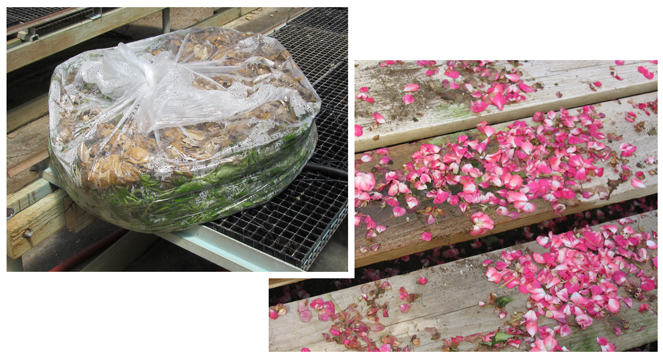______________________________________________________________________________________________________________________________________________________________
Sanitation for Greenhouse Crops
By A. R. Chase, Chase Agricultural Consulting, LLC
Many diseases can be avoided when a thorough and consistent sanitation program is in place. Stopping disease before it becomes established is critical and always more cost effective. Some of the steps included in this article include “cleaning” with physical and chemical means. It can include cleaning the greenhouse, pots and flats, or cleaning seeds or other plant propagules. The best method of sanitation isn’t a single approach, but relies on a combination, including physical and chemical means.
Cleaning the greenhouse/nursery
Physical cleaning - Get rid of weeds (including moss and liverworts), volunteer plants, pet plants and potting media debris. They harbor bacteria and fungi that can cause disease. Surfaces can be hard to clean since organic matter by its very nature disables many “oxidants” like bleach and chlorine dioxide. Cleaning up dead flowers (even fallen petals) can be an important way to reduce Botrytis spread. Try a blower to remove fallen petals of small flowers. Hand picking larger flowers or infected leaves reduces Botrytis spread into the crop.
Non-porous surfaces - Cleaning porous surfaces like wood and dirt (floors) makes your job much harder than using nonporous surfaces like metal, concrete or plastic. Gravel is a sort of combination of porous and non-porous surfaces since rock may be easy to clean but gravel has a lot of crop and potting medium debris in it that is not easy to clean. Capillary mats are also very hard to clean due to their ability to store water and everything from algae, to fungi and bacteria - not to mention insect pests. Depending on the type of surface, treating with disinfectants like Green-Shield II, KleenGrow and ZeroTol 2.0 between crops is critical.
Chemical cleaning agents for surfaces
The most common “disinfectants” used in our industry are based on chlorine - from bleach to chlorine dioxide, to hydrogen peroxides and quaternary ammoniums. They have different abilities to “clean” benches, walkways, pots and tools. Even the type of surface (wood, plastic or concrete) can influence which product may work best. Our trials have shown better control of plant pathogens on wood, plastic and concrete when KleenGrow is utilized with Strip-It applied first. KleenGrow has residual control ability not present in many other products. It is also safer on plants than some of the other disinfectants.
Alcohol and quaternary ammoniums are routinely used for foot baths, hand washing stations and cutting tools since they are effective and human friendly. Make sure everyone knows how to use them and does not bypass these sanitation steps.
Cuttings cannot tolerate much more toxic products than humans making use of chlorine-based products unlikely. However chlorine and peroxides, which are hard on cuttings, have been used to treat seeds since seeds are somewhat resistant to oxidants. Test safety on seeds or cuttings before broad scale use.
Cleaning water
No matter what your reason is for reusing water, from environmental to legal to financial, you must consider water treatment. Many research studies on Phytophthora and Pythium show that if you have these fungi causing crop losses and you recirculate your water, you will likely be infecting new plants with these diseases.
Methods for water treatment range from slow sand filtration to ultra-violet light, ozonation, copper ionization and chemical disinfectants (like chlorine). Research shows that the amount of chlorine needed to kill Phytophthora zoospores, that is 2ppm of free chlorine, is more effective and still safe for the crops being treated. There is a large difference between cleaning the water before re-use and treating the water on a constant basis (such as in propagation). The rates of product used will not be the same or at least not have the same safety to the crop.
Conclusions
Sanitation is not accomplished in a single step. It is a commitment to an ongoing series of steps that requires a change of mindset for employees. Periodic training is critical, especially when you adopt a new method.
One final thought - Remember that if it looks clean it is more likely to be clean.

Depending on the type of surface, treating with disinfectants like Green-Shield II, KleenGrow and ZeroTol 2.0 between crops is critical.

Sanitation is a commitment to an ongoing series of steps that requires a change of mindset for employees.
Always read and follow label directions.

